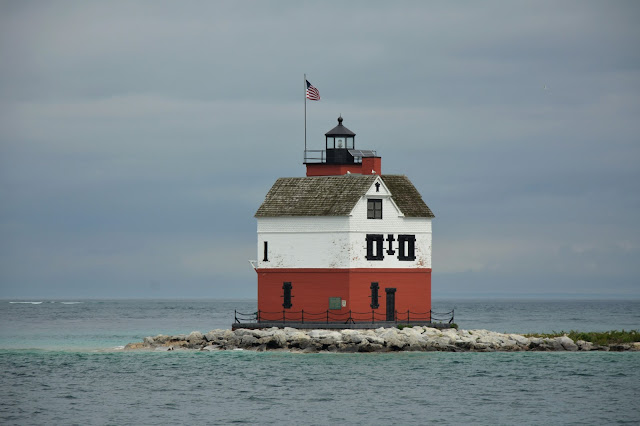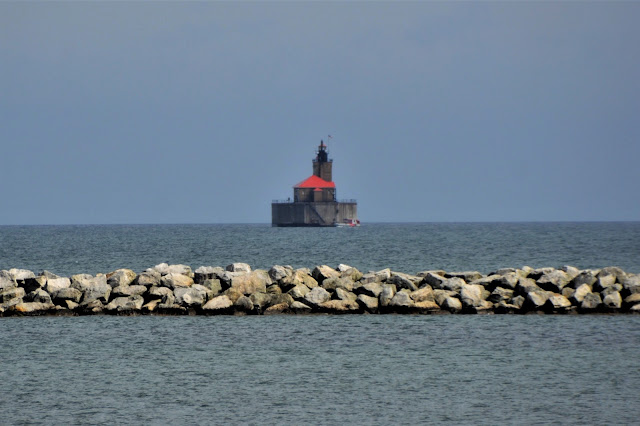
Sunday, September 30, 2018
POE REEF LIGHTHOUSE - LAKE HURON, MICHIGAN
Poe Reef Lighthouse - 1932
Photograph Courtesy U.S. Coast Guard
NAVIGATION - LAKE HURON
Cheboygan Lighthouse was built in 1851 to guide mariners through the South Channel that passes between the northern end of Michigan’s Lower Peninsula and the southern side of Bois Blanc Island. As vessels with deeper drafts became more common on the Great Lakes, shoals in the South Channel started to pose a significant threat, especially during storms. Numerous lightships were stationed in these regions, with the first one on September 29, 1893. The Lake Carriers’ Association had requested a permanent lighthouse and fog signal for Poe Reef as early as 1913, but it wasn’t until 1926 that the Commissioner of Lighthouses requested funds for such a project. Besides being less costly to maintain, lighthouses had an additional advantage over lightships: they could remain on station throughout the year rather than having to be withdrawn when ice started to form on the lakes. Congress made an initial appropriation of $78,000 in early 1927 that allowed work to begin that summer on a timber crib to serve as the lighthouse’s foundation. A site on Cheboygan River, seven miles from the reef, was leased as a base for operations, and the construction camp on Government Island used while building Martin Reef Lighthouse was moved there. A district force under the direction of Foreman John Sellman built the crib using twelve-inch-square timbers, and when it was complete, the crib was towed out into the lake by the tenders Marigold and Aspen and sunk in twenty-four feet of water on the southeast end of Poe Reef. Once the deck was completed and the frame for the lighthouse was erected, a bunkhouse was hoisted atop the crib on September 13, 1928 so the men could live on-site. Before the lighthouse was completed, several tyfon and diaphone fog horns were mounted outside the structure and tests were conducted on June 28 and 29 of 1929. Poe Reef Lighthouse commenced operation on August 15, 1929, and the last lightship, LV 99 was withdrawn and transferred to the twelfth district. The entire pier above the crib top is of mass concrete with steel reinforcing in the overhang and elsewhere as needed. Basement and storage vaults lighted from the deck are provided within the pier. The superstructure is of steel with masonry backing. The tower is rectangular with buttressed corners supporting a watch room with gallery and a third-order lens and lantern; focal plane, 71 feet above water level. The tower proper comprises three floors. The first floor houses the mechanical equipment and the second and third floors provide living accommodations which are adequate for three keepers. Illuminating apparatus: Original lens - electric in a third-order fixed lens giving a candlepower of about 24,000. Current lens - 14.8" (375 mm) Tideland Signal acrylic Optic. The double-flashing characteristic (Iso W 2s) is produced by motor-driven flashers. Range: 9 nautical miles (17 km). Fog signal: The fog signal is an air diaphone of powerful type supplied with air from oil-engine-driven air compressors, 1 every 30 seconds. A low power radiobeacon forms a part of the equipment. The entire fog-signal and radiobeacon equipment is in duplicate, including the electric generating equipment.
SPECTACLE REEF LIGHTHOUSE - LAKE HURON, MICHIGAN
Spectacle Lighthouse - 1902
Photograph Courtesy National Archives
Spectacle Lighthouse - 1906
Photograph Courtesy U.S. Coast Guard
NAVIGATION - LAKE HURON
"The lighthouse is 11 miles (18 km) east of the Straits
of Mackinac and is located at the northern end of Lake Huron, Michigan. It was
designed and built by Colonel Orlando Metcalfe and Major Godfrey Weitzel and
was the most expensive lighthouse ever built on the Great Lakes. The site was
first marked by a buoy in 1868. The construction was undertaken under the
auspices of the Lighthouse Board, and was a feat of civil engineering and
endurance. Construction began in 1870, in answer to the disastrous loss of a
large number of ships during the 1860s at the site; in particular, two
schooners ran aground and broke up in 1867. The massive cost of the loss helped
convince Congress that it would be more cost effective to build a light and
reduce the potential of future shipwrecks. The lighthouse is built upon a reef
shaped like a pair of eyeglasses (hence its name) and is located in the path of
littoral commerce on Lake Huron. The increase in freighter traffic through the
straits increased the risk of more ship losses without better signing of
hazards. The Spectacle Reef Lighthouse cost $406,000. The tower is formed as a
"frustum of a cone". The 32-foot (9.8 m) diameter base rises 93 feet
(28 m) above water level, and is 11 feet (3.4 m) below water level. As the
Coast Guard notes: "The focal plane is 4 feet 3 inches (1.30 m) above the
top of the parapet, making it 97 feet 3 inches (29.64 m) above the top of the
submerged rock and 86 feet 3 inches (26.29 m) above the surface of the water.
For 34 feet (10 m) up the tower is solid and from them on up it is hollow. In
it are five rooms, one above the other each 14 feet (4.3 m) in diameter, with
varying heights. The walls of the hollow portion are 5 feet 6 inches (1.68 m)
at the bottom, tapering to 16 inches (410 mm) at the spring of the cornice. The
light has an attached fog building, oil house and storage building. There are
davits to raise and lower boats. Original
lens was a Second-order Fresnel lens, current lens is a Solar powered 300 mm
Tideland Signal acrylic lens. Intensity: 400,000 candlepower white; 80,000
candlepower red. Range: 11 nautical miles (20km). Characteristic: Flashing
alternately white every 60 seconds, red every 5 seconds. Operates year round.
100 candlepower white winter light which flashes every 5 seconds. Fog signal:
air-diaphone."
Saturday, September 29, 2018
BOIS BLANC ISLAND LIGHTHOUSE - BOIS BLANC ISLAND, MICHIGAN
Bois Blanc Island Lighthouse - 1904
Photograph Courtesy National Archives
NAVIGATION - STRAITS OF MACKINAC/LAKE HURON
On May 23, 1828, Congress appropriated $5,000 for a lighthouse on Bois Blanc Island; the first of three lighthouses that were built. Due to poor engineering and construction, and an unordinary rise in the Lake’s water the first two eventually collapsed. The Lighthouse Board were notified apparently that when concern that lighthouses were built in a very economical manner, the resulting structures didn’t always last. An 1866 report noted that Bois Blanc Lighthouse was of a “defective style and pattern” and “in a very dilapidated condition.” The Lighthouse Board requested $14,000 for a new lighthouse, and this amount was granted by Congress on March 2, 1867. Work on the third Bois Blanc Lighthouse, the one that remains standing today, began on July 1, 1867 and wrapped up later that year. Unlike its predecessors which had a detached tower, the 1867 lighthouse consisted of a yellow-brick, one-and-a-half-story dwelling with a square tower attached to its lakeward end. In 1884, the station’s boathouse was moved to a more sheltered location on the south side of the island, where a new landing dock was built. A brick cistern was placed in the dwelling’s cellar in 1891, and the lighthouse’s downspouts were extended to it. A well was also sunk in 1891 near the beach east of the lighthouse and equipped with a pump and rubber house to augment the dwelling’s water supply and to provide fire protection. Height: Tower – 38’ (12 m), Focal Height: Focal plane -53’ (16 m). Original lens in the third lighthouse was a Fourth order Fresnel lens – which was removed. Bois Blanc Lighthouse was decommissioned in 1924, and in its place, a light was displayed from a forty-six-foot-tall black skeleton tower near the shore. The light was moved in 1942 and placed atop a white skeleton tower, which served as a better daymark. The current cylindrical tower near Bois Blanc Lighthouse was erected in 1986.
Subscribe to:
Comments (Atom)




















































